#Cloud based testing software
Explore tagged Tumblr posts
Text
https://www.qapitol.com/saas-technology/
SaaS testing | Cloud based testing software | cloud testing
Build a powerful test automation solution to eliminate manual testing and optimize test execution time to create quality products and deliver a seamless user experience
#SaaS testing#Cloud based testing software#cloud testing#quality engineering#intelligent test automation
0 notes
Text
How Load Testing Enhances User Experience and Application Stability
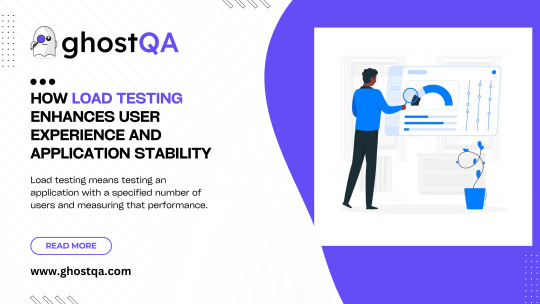
User experience and application stability are crucial in today's digital world. Be it an e-commerce site in festival sale or a game with millions of concurrent players or a Saas to back global enterprises; all of them must be ready to bear the load and this is why load testing becomes a necessity!
Load testing is the process of experimenting on an application with a group of users, so that you could determine its behavior when it has large (or not so large) amount people using it. This would be useful to identify any possibly slow bottlenecks, ensure proper performance of applications and clean user experience. This blog talks about load testing, helping to improve the user experience, ensuring the stability of the application and the necessity of load testing in contemporary applications.
What is Load Testing?
Load testing means testing an application with a specified number of users and measuring that performance. Teams can now look at response times, throughput and resource utilization under different conditions to predict the application parameters so that during high load the app behaves as intended.
Before the end-users face it, this way of proactive testing helps in finding the performance problems like slow load times or crash or server overload.
The Role of Load Testing in Enhancing User Experience
Faster Load Times
Users have a high expectation of how fast applications load, and any delays in that process often result in frustration or abandonment.
Load testing helps reveal slow-loading elements so that developers can optimize code and server configurations and result in faster response time.
Consistent Performance Across Devices
Make sure applications work well on various devices and platforms.
Load testing which virtually loads various devices are kept ensuring the homogeneity of all users.
Seamless Navigation During Peak Traffic
Servers may have to work extra hard, scenarios like flash sales or the launch of a product often lead to high traffic.
Load testing is done to ensure these types of applications can be prepared for these types of scenarios beforehand and tackle spikes without a slow-down.
Increased Customer Satisfaction
A non-crashing responsive application is a good user experience.
By identifying and addressing performance issues before they impact customers, load testing increases retention rates and creates brand loyalty.
How Load Testing Boosts Application Stability
Prevents Downtime
Unexpected traffic surges can cause servers to crash, resulting in downtime.
Load testing is to simulate the above scenario and to help identify the weak points and strengthen the server at capacity.
Detects Memory Leaks and Resource Bottlenecks
Memory leaks or high CPU usage under load could affect resource-intensive applications.
Load testing allows teams to pinpoint and resolve such problems before they become critical.
Ensures Scalability
Applications now must scale and that means increasing user numbers.
Load testing keeps an eye on the ability of an application to take on the load that the real world represents without losing efficiency or stability.
Validates Infrastructure Readiness
Simulated loads are the best way to test the infrastructure to make sure the backend works in real time.
Load testing includes testing on databases, APIs, and server configurations.
Improves Disaster Recovery Readiness
Load testing helps prepare teams for real-world failures by testing how an application recovers after a crash or an overload.
Best Practices for Load Testing
Define Clear Objectives
Identify your application’s performance goals before you begin. Defining how fast a response can be on a certain load and throughput level is one way to set deterministic guidelines.
Simulate Realistic User Behavior
Tools such as JMeter allow you to simulate actual customer actions (navigating, searching, buying, etc.). This ensures that the insights are correct.
Test in Stages
Conduct tests from normal user loads and scale up to peak loads will allow us to find patterns of degradation.
Use Cloud-Based Load Testing
Cloud resources enable testing in various geographical locations that present a true perspective on how well your application performs around the world.
Leverage Automation
Time is one of the many advantages of automated load testing tools, and they also allow for consistent testing due to the load generation code being the same.
The GhostQA Advantage in Load Testing
The GhostQA Load Testing Engine is based on JMeter. It gives an easier solution for performance testing. So here is what makes GhostQA different:
Low Code Testing Approach: Generate complex load tests with writing low code scripts, accessible to QA teams of any experience level.
Auto-Healing Features: With GhostQA, it adjusts to the changes in the application, which in turn reduces test maintenance efforts.
Comprehensive Reporting: In-depth test reports offer insights to optimize application performance.
Scalability: With minimal effort, you can simulate realistic loads and can test your application for stability.
GhostQA enables teams to include load testing right into their QA process for quality software that actually holds up in the real world.
Real-Life Applications of Load Testing
E-commerce Platforms: Prepare the website for events featuring high traffic such as seasonal sales or other promotions.
Gaming Applications: Validate your app is not only up but also do not crash under high usage workloads like a game release.
Streaming Services: Testing the quality of the stream under user load.
SaaS Applications: Ensure consistent performance to end users around the globe.
Banking Applications: Make sure that it is available even with high transactional load like days when the payroll is processed.
Conclusion
Load testing is key to delivering the high-quality software your customers expect. This stimulates the real factors that prevent the system from being unreal, and its agencies help to identify bottlenecks that improve operation and application stability.
GhostQA is a Performance testing automation tool that is AI based for load testing for the codeless platform. Solutions like GhostQA empower organizations to make sure that their applications are resilient, scalable, and ready to face the real-world load.
Begin Load Testing right from now to deliver an excellent user experience by stabilizing the application. Your users will be grateful for that!
#Load testing#Load Testing tools#Test automation#Scalability Testing#Cloud-Based Load Testing#User Experience#software#software testing#quality assurance#functional testing#automated testing
0 notes
Text
Cloud-based Non-Destructive Testing (NDT) management software is a digital platform hosted on cloud servers to streamline, manage, and analyze NDT processes and data. It enables real-time collaboration, centralized data storage, and enhanced accessibility for NDT professionals, improving the efficiency and accuracy of testing operations in industries like oil & gas, aerospace, automotive, and construction. The cloud-based NDT management software market is growing steadily, supported by the increasing digitalization of industrial operations. Small and medium-sized enterprises (SMEs) are also contributing to this growth, as they adopt cost-effective cloud solutions to enhance operational efficiency. Furthermore, the market is seeing rising demand for scalable and subscription-based models that cater to diverse operational needs.
0 notes
Text
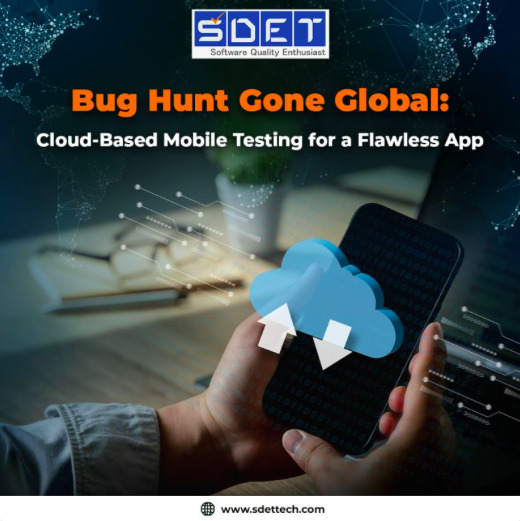
Embark on a global bug hunt with our SDET team, leveraging cloud-based mobile testing to ensure your app achieves flawless performance across all devices and networks. With cutting-edge tools and a meticulous approach, we identify and eliminate bugs before they impact your users. https://rb.gy/jfueow #SDET #BugHunt #CloudTesting #MobileAppQuality #FlawlessPerformance SDET Tech Pvt. Ltd.
#Software Testing Companies in India#Software Testing Services in India#Test Automation Development Services#Test Automation Services#Performance testing services#Load testing services#Performance and Load Testing Services#Software Performance Testing Services#Functional Testing Services#Globalization Testing services#Globalization Testing Company#Accessibility testing services
Agile Testing Services#Mobile Testing Services#Mobile Apps Testing Services#ecommerce performance testing#ecommerce load testing#load and performance testing services#performance testing solutions#product performance testing#application performance testing services#software testing startups#benefits of load testing#agile performance testing methodology#agile testing solutions#mobile testing challenges#cloud based mobile testing#automated mobile testing#performance engineering & testing services#performance testing company#performance testing company in usa
0 notes
Text
Revolutionizing Software Quality: Unleashing the Power of AI Testing Services with V2Soft
In the ever-evolving landscape of IT testing services, Artificial Intelligence (AI) has emerged as a game-changer, redefining the way software quality is assured. This blog explores the transformative realm of AI testing services, with a focus on V2Soft and why it stands out as the preferred choice. Dive into the future of software testing, where AI, coupled with V2Soft's expertise, takes center stage.
AI Testing Services: A Paradigm Shift in Software Quality Assurance
1. Precision and Efficiency:
AI-driven testing services bring unparalleled precision to the software testing process. V2Soft harnesses the power of advanced AI algorithms to identify and address potential issues with pinpoint accuracy, ensuring that software products meet the highest quality standards.
2. Automated Testing for Cloud Computing:
The advent of cloud computing has revolutionized the IT landscape, demanding robust testing solutions. V2Soft's AI testing services excel in automated testing for cloud-based applications, ensuring seamless integration and optimal performance in cloud environments.
3. Scalability and Flexibility:
AI testing services provided by V2Soft are designed to scale with your business. As your IT infrastructure evolves, our flexible testing solutions adapt to new challenges, guaranteeing a seamless testing process that grows with your organization.
Choose V2Soft for AI Testing Services: Unmatched Expertise and Innovation
1. Proven Excellence in IT Testing Services:
With a legacy of over 20 years in IT testing services, V2Soft has a proven track record of delivering top-notch solutions. Our expertise spans a wide range of industries, ensuring that your software undergoes rigorous testing tailored to industry-specific requirements.
2. Specialization in Cloud Computing Testing:
V2Soft's commitment to staying at the forefront of technology is evident in our specialization in cloud computing testing. Our AI-driven testing services are optimized for cloud environments, providing a comprehensive solution for businesses leveraging cloud infrastructure.
3. Continuous Innovation with AI:
At V2Soft, we embrace innovation as a cornerstone of our approach. Our AI testing services are continuously updated to incorporate the latest advancements in artificial intelligence, ensuring that your software benefits from cutting-edge testing methodologies.
4. Streamlined Processes for Maximum Efficiency:
V2Soft prioritizes efficiency in every aspect of our AI testing services. From test case generation to result analysis, our streamlined processes minimize testing time without compromising on the thoroughness of the testing process, guaranteeing rapid and reliable results.
Conclusion:
In the dynamic landscape of AI testing services, V2Soft stands out as a leader committed to delivering excellence. By choosing V2Soft as your partner in AI testing, you gain access to a wealth of experience, unmatched innovation, and a tailored approach that ensures the highest quality for your software projects. Transform your software testing experience – choose V2Soft for AI testing services that redefine industry standards and propel your business to new heights.
0 notes
Text
The Future of Cloud-Based Software in the Publishing Industry
Introduction
The publishing industry has undergone significant transformations over the years, with the advent of digital technologies revolutionizing the way content is created, distributed, and consumed. One of the most transformative innovations in recent times is cloud-based software. Cloud computing has gained immense popularity across various sectors, and its impact on the publishing industry is no exception. The move towards cloud-based solutions in the publishing industry is the consequence of a desire—or perhaps even a requirement—to automate work processes, reduce costs, and lessen the strain on an organization’s need for technological know-how.

The Rise of Cloud-based Software in Publishing
Cloud-based computing is one of the more recent technological advancements and has become an accepted standard practice in many businesses. Without even realizing it, a lot of the common tasks that businesses use on platforms like Salesforce.com, operate on cloud-based standards, as data storage and management are handled by off-site server farms rather than by the company’s own local servers or hard drives. There are countless use cases for publishers who are considering migrating portions of their business practices to the cloud. This rise in traction and popularity of Cloud technology in the publishing industry can be attributed to its numerous advantages.
Accessibility and Collaboration: Cloud-based software allows publishers to access their tools and applications from anywhere with an internet connection, enabling remote work and collaboration. Teams can collaborate in real-time, share and edit documents, and streamline workflows, regardless of their physical location.
Scalability and Cost Efficiency: Cloud-based solutions offer scalability, allowing publishers to expand or downsize their resources based on their requirements. Additionally, the pay-as-you-go model eliminates the need for large upfront investments, reducing costs and making it more affordable for publishers, especially small and medium-sized enterprises (SMEs).
Enhanced Security and Backup: Cloud service providers invest heavily in security measures, ensuring data protection and disaster recovery. Publishers can benefit from robust security protocols, encrypted data storage, and automatic backups, minimizing the risk of data loss or breaches.
Streamlined Publishing Processes: Cloud-based software streamlines various publishing processes, such as content creation, editing, layout design, and distribution. Publishers can leverage powerful tools to automate repetitive tasks, enhance productivity, and improve overall efficiency.
The Future Outlook
Content Creation and Collaboration: Cloud-based software will continue to advance content creation and collaboration in the publishing industry. Tools like Google Docs and Microsoft Office 365 have already gained popularity, allowing multiple users to collaborate in real-time. Future innovations will likely offer more sophisticated features, such as AI-powered content generation and intelligent editing tools, revolutionizing the way publishers create and refine their content.
Digital Asset Management: As the amount of digital content continues to grow, efficient digital asset management (DAM) becomes crucial. Cloud-based DAM systems enable publishers to organize, store, and retrieve digital assets seamlessly. AI and machine learning algorithms can enhance metadata tagging, search capabilities, and content recommendation, further streamlining the content management process.
Data-driven Publishing: Cloud-based software provides publishers with valuable data insights, helping them understand audience preferences, analyze market trends, and make data-driven decisions. Advanced analytics tools integrated into cloud-based publishing platforms can offer comprehensive metrics on content performance, reader engagement, and revenue generation, empowering publishers to optimize their strategies and drive better outcomes.
Personalized Reader Experiences: Cloud-based software enables publishers to deliver personalized reader experiences, tailoring content recommendations based on user preferences and behaviors. By leveraging data analytics and machine learning algorithms, publishers can create customized content, targeted marketing campaigns, and interactive digital experiences, fostering deeper reader engagement and loyalty.
Companies can even move processes related to Contracts and rights management, Supplier qualification management and paper procurement to cloud, to streamline its operation management.
Challenges and Considerations
Utilizing cloud-based services has been can benefit publishers in a variety of ways, including content management, lead generation and other business services. Since there is no one solution that works for everyone, publishers need to be well-informed about the benefits and drawbacks of any shift around cloud computing. On that note, certain challenges and considerations in particular need to be addressed:
Data Security and Privacy: As publishers entrust their content and sensitive data to third-party cloud service providers, ensuring robust security measures and compliance with data protection regulations becomes crucial. Publishers must carefully select reputable and trustworthy providers with strong security protocols.
Integration and Interoperability: Publishers often rely on a variety of software applications for different aspects of their workflow. Ensuring seamless integration and interoperability between cloud-based tools and existing systems is essential to avoid disruptions and maximize efficiency.
Connectivity and Reliability: Dependence on internet connectivity for accessing cloud-based software can pose challenges in areas with limited or unreliable internet infrastructure. Publishers must consider backup solutions and contingency plans to minimize disruptions during connectivity issues.
Conclusion
Cloud-based software has already made a significant impact on the publishing industry, revolutionizing content creation, collaboration, and distribution. For a particular organization, how much it can benefit from Cloud-based software will depend on the nature of its business model and the level of adoption of new technology. However, it will be a key factor in publishing of content at a pace that keeps up with our consumption of it. Therefore, the future of cloud-based software in publishing is promising, with advancements in content creation, digital asset management, data-driven publishing, and personalized reader experiences. While challenges like data security, integration, and connectivity persist, the benefits of cloud-based software far outweigh the drawbacks. Publishers who embrace this technology will be better equipped to thrive in the ever-evolving digital publishing landscape.
0 notes
Text
"As a Deaf man, Adam Munder has long been advocating for communication rights in a world that chiefly caters to hearing people.
The Intel software engineer and his wife — who is also Deaf — are often unable to use American Sign Language in daily interactions, instead defaulting to texting on a smartphone or passing a pen and paper back and forth with service workers, teachers, and lawyers.
It can make simple tasks, like ordering coffee, more complicated than it should be.
But there are life events that hold greater weight than a cup of coffee.
Recently, Munder and his wife took their daughter in for a doctor’s appointment — and no interpreter was available.
To their surprise, their doctor said: “It’s alright, we’ll just have your daughter interpret for you!” ...
That day at the doctor’s office came at the heels of a thousand frustrating interactions and miscommunications — and Munder is not isolated in his experience.
“Where I live in Arizona, there are more than 1.1 million individuals with a hearing loss,” Munder said, “and only about 400 licensed interpreters.”
In addition to being hard to find, interpreters are expensive. And texting and writing aren’t always practical options — they leave out the emotion, detail, and nuance of a spoken conversation.
ASL is a rich, complex language with its own grammar and culture; a subtle change in speed, direction, facial expression, or gesture can completely change the meaning and tone of a sign.
“Writing back and forth on paper and pen or using a smartphone to text is not equivalent to American Sign Language,” Munder emphasized. “The details and nuance that make us human are lost in both our personal and business conversations.”
His solution? An AI-powered platform called Omnibridge.
“My team has established this bridge between the Deaf world and the hearing world, bringing these worlds together without forcing one to adapt to the other,” Munder said.
Trained on thousands of signs, Omnibridge is engineered to transcribe spoken English and interpret sign language on screen in seconds...
“Our dream is that the technology will be available to everyone, everywhere,” Munder said. “I feel like three to four years from now, we're going to have an app on a phone. Our team has already started working on a cloud-based product, and we're hoping that will be an easy switch from cloud to mobile to an app.” ...
At its heart, Omnibridge is a testament to the positive capabilities of artificial intelligence. "
-via GoodGoodGood, October 25, 2024. More info below the cut!
To test an alpha version of his invention, Munder welcomed TED associate Hasiba Haq on stage.
“I want to show you how this could have changed my interaction at the doctor appointment, had this been available,” Munder said.
He went on to explain that the software would generate a bi-directional conversation, in which Munder’s signs would appear as blue text and spoken word would appear in gray.
At first, there was a brief hiccup on the TED stage. Haq, who was standing in as the doctor’s office receptionist, spoke — but the screen remained blank.
“I don’t believe this; this is the first time that AI has ever failed,” Munder joked, getting a big laugh from the crowd. “Thanks for your patience.”
After a quick reboot, they rolled with the punches and tried again.
Haq asked: “Hi, how’s it going?”
Her words popped up in blue.
Munder signed in reply: “I am good.”
His response popped up in gray.
Back and forth, they recreated the scene from the doctor’s office. But this time Munder retained his autonomy, and no one suggested a 7-year-old should play interpreter.
Munder’s TED debut and tech demonstration didn’t happen overnight — the engineer has been working on Omnibridge for over a decade.
“It takes a lot to build something like this,” Munder told Good Good Good in an exclusive interview, communicating with our team in ASL. “It couldn't just be one or two people. It takes a large team, a lot of resources, millions and millions of dollars to work on a project like this.”
After five years of pitching and research, Intel handpicked Munder’s team for a specialty training program. It was through that backing that Omnibridge began to truly take shape...
“Our dream is that the technology will be available to everyone, everywhere,” Munder said. “I feel like three to four years from now, we're going to have an app on a phone. Our team has already started working on a cloud-based product, and we're hoping that will be an easy switch from cloud to mobile to an app.”
In order to achieve that dream — of transposing their technology to a smartphone — Munder and his team have to play a bit of a waiting game. Today, their platform necessitates building the technology on a PC, with an AI engine.
“A lot of things don't have those AI PC types of chips,” Munder explained. “But as the technology evolves, we expect that smartphones will start to include AI engines. They'll start to include the capability in processing within smartphones. It will take time for the technology to catch up to it, and it probably won't need the power that we're requiring right now on a PC.”
At its heart, Omnibridge is a testament to the positive capabilities of artificial intelligence.
But it is more than a transcription service — it allows people to have face-to-face conversations with each other. There’s a world of difference between passing around a phone or pen and paper and looking someone in the eyes when you speak to them.
It also allows Deaf people to speak ASL directly, without doing the mental gymnastics of translating their words into English.
“For me, English is my second language,” Munder told Good Good Good. “So when I write in English, I have to think: How am I going to adjust the words? How am I going to write it just right so somebody can understand me? It takes me some time and effort, and it's hard for me to express myself actually in doing that. This technology allows someone to be able to express themselves in their native language.”
Ultimately, Munder said that Omnibridge is about “bringing humanity back” to these conversations.
“We’re changing the world through the power of AI, not just revolutionizing technology, but enhancing that human connection,” Munder said at the end of his TED Talk.
“It’s two languages,” he concluded, “signed and spoken, in one seamless conversation.”"
-via GoodGoodGood, October 25, 2024
#ai#pro ai#deaf#asl#disability#translation#disabled#hard of hearing#hearing impairment#sign language#american sign language#languages#tech news#language#communication#good news#hope#machine learning
500 notes
·
View notes
Text
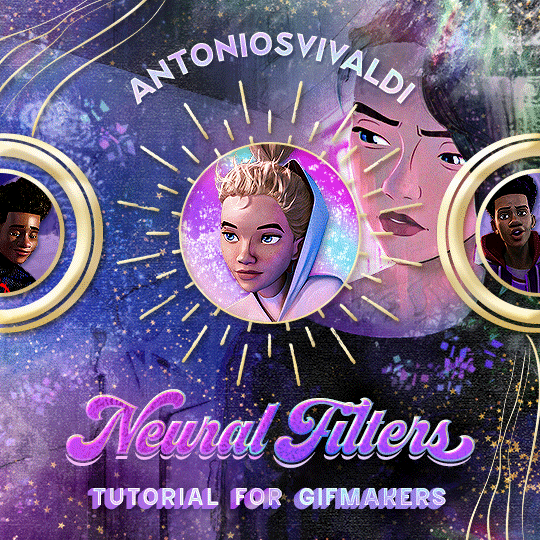
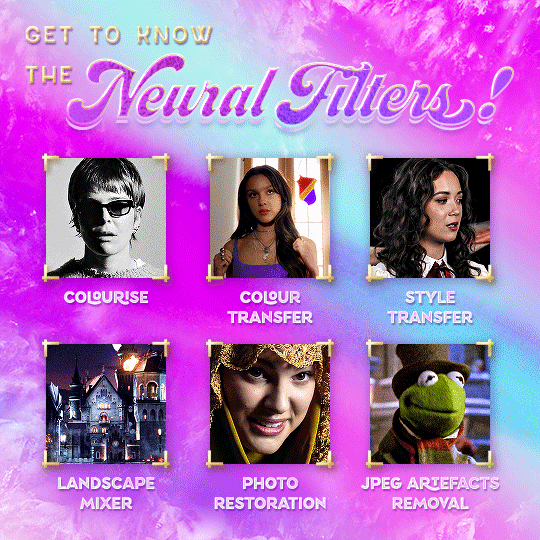



Neural Filters Tutorial for Gifmakers by @antoniosvivaldi
Hi everyone! In light of my blog’s 10th birthday, I’m delighted to reveal my highly anticipated gifmaking tutorial using Neural Filters - a very powerful collection of filters that really broadened my scope in gifmaking over the past 12 months.
Before I get into this tutorial, I want to thank @laurabenanti, @maines , @cobbbvanth, and @cal-kestis for their unconditional support over the course of my journey of investigating the Neural Filters & their valuable inputs on the rendering performance!
In this tutorial, I will outline what the Photoshop Neural Filters do and how I use them in my workflow - multiple examples will be provided for better clarity. Finally, I will talk about some known performance issues with the filters & some feasible workarounds.
Tutorial Structure:
Meet the Neural Filters: What they are and what they do
Why I use Neural Filters? How I use Neural Filters in my giffing workflow
Getting started: The giffing workflow in a nutshell and installing the Neural Filters
Applying Neural Filters onto your gif: Making use of the Neural Filters settings; with multiple examples
Testing your system: recommended if you’re using Neural Filters for the first time
Rendering performance: Common Neural Filters performance issues & workarounds
For quick reference, here are the examples that I will show in this tutorial:
Example 1: Image Enhancement | improving the image quality of gifs prepared from highly compressed video files
Example 2: Facial Enhancement | enhancing an individual's facial features
Example 3: Colour Manipulation | colourising B&W gifs for a colourful gifset
Example 4: Artistic effects | transforming landscapes & adding artistic effects onto your gifs
Example 5: Putting it all together | my usual giffing workflow using Neural Filters
What you need & need to know:
Software: Photoshop 2021 or later (recommended: 2023 or later)*
Hardware: 8GB of RAM; having a supported GPU is highly recommended*
Difficulty: Advanced (requires a lot of patience); knowledge in gifmaking and using video timeline assumed
Key concepts: Smart Layer / Smart Filters
Benchmarking your system: Neural Filters test files**
Supplementary materials: Tutorial Resources / Detailed findings on rendering gifs with Neural Filters + known issues***
*I primarily gif on an M2 Max MacBook Pro that's running Photoshop 2024, but I also have experiences gifmaking on few other Mac models from 2012 ~ 2023.
**Using Neural Filters can be resource intensive, so it’s helpful to run the test files yourself. I’ll outline some known performance issues with Neural Filters and workarounds later in the tutorial.
***This supplementary page contains additional Neural Filters benchmark tests and instructions, as well as more information on the rendering performance (for Apple Silicon-based devices) when subject to heavy Neural Filters gifmaking workflows
Tutorial under the cut. Like / Reblog this post if you find this tutorial helpful. Linking this post as an inspo link will also be greatly appreciated!
1. Meet the Neural Filters!
Neural Filters are powered by Adobe's machine learning engine known as Adobe Sensei. It is a non-destructive method to help streamline workflows that would've been difficult and/or tedious to do manually.
Here are the Neural Filters available in Photoshop 2024:
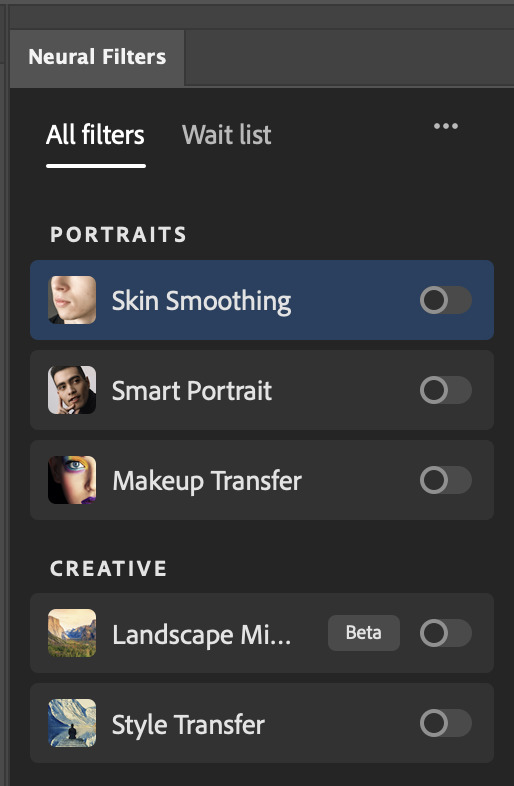

Skin Smoothing: Removes blemishes on the skin
Smart Portrait: This a cloud-based filter that allows you to change the mood, facial age, hair, etc using the sliders+
Makeup Transfer: Applies the makeup (from a reference image) to the eyes & mouth area of your image
Landscape Mixer: Transforms the landscape of your image (e.g. seasons & time of the day, etc), based on the landscape features of a reference image
Style Transfer: Applies artistic styles e.g. texturings (from a reference image) onto your image
Harmonisation: Applies the colour balance of your image based on the lighting of the background image+
Colour Transfer: Applies the colour scheme (of a reference image) onto your image
Colourise: Adds colours onto a B&W image
Super Zoom: Zoom / crop an image without losing resolution+
Depth Blur: Blurs the background of the image
JPEG Artefacts Removal: Removes artefacts caused by JPEG compression
Photo Restoration: Enhances image quality & facial details
+These three filters aren't used in my giffing workflow. The cloud-based nature of Smart Portrait leads to disjointed looking frames. For Harmonisation, applying this on a gif causes Neural Filter timeout error. Finally, Super Zoom does not currently support output as a Smart Filter
If you're running Photoshop 2021 or earlier version of Photoshop 2022, you will see a smaller selection of Neural Filters:

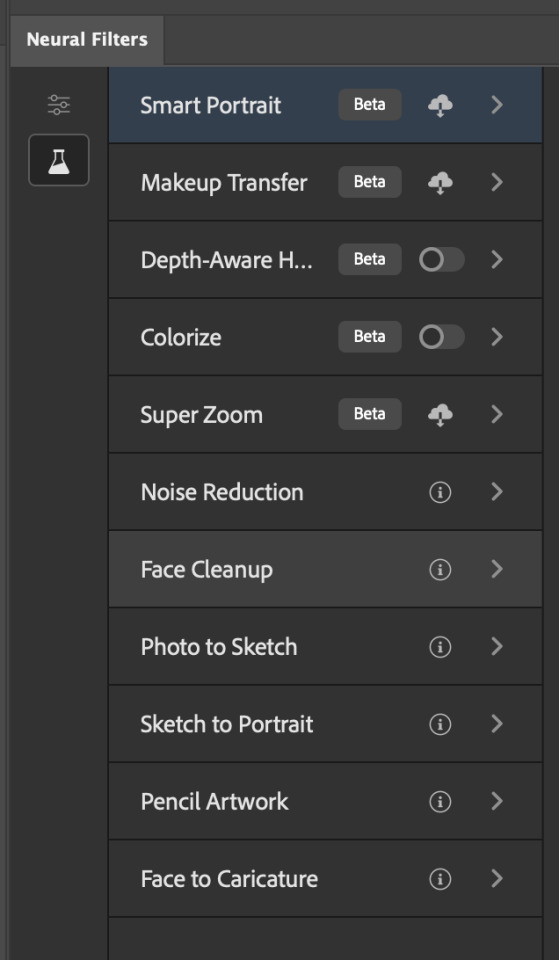
Things to be aware of:
You can apply up to six Neural Filters at the same time
Filters where you can use your own reference images: Makeup Transfer (portraits only), Landscape Mixer, Style Transfer (not available in Photoshop 2021), and Colour Transfer
Later iterations of Photoshop 2023 & newer: The first three default presets for Landscape Mixer and Colour Transfer are currently broken.
2. Why I use Neural Filters?
Here are my four main Neural Filters use cases in my gifmaking process. In each use case I'll list out the filters that I use:
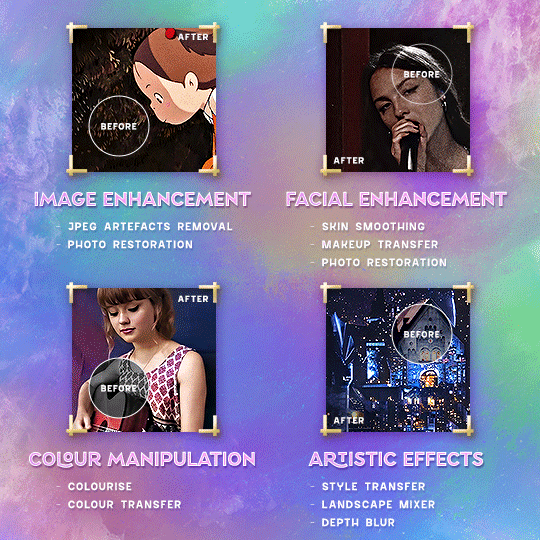
Enhancing Image Quality:
Common wisdom is to find the highest quality video to gif from for a media release & avoid YouTube whenever possible. However for smaller / niche media (e.g. new & upcoming musical artists), prepping gifs from highly compressed YouTube videos is inevitable.
So how do I get around with this? I have found Neural Filters pretty handy when it comes to both correcting issues from video compression & enhancing details in gifs prepared from these highly compressed video files.
Filters used: JPEG Artefacts Removal / Photo Restoration
Facial Enhancement:
When I prepare gifs from highly compressed videos, something I like to do is to enhance the facial features. This is again useful when I make gifsets from compressed videos & want to fill up my final panel with a close-up shot.
Filters used: Skin Smoothing / Makeup Transfer / Photo Restoration (Facial Enhancement slider)
Colour Manipulation:
Neural Filters is a powerful way to do advanced colour manipulation - whether I want to quickly transform the colour scheme of a gif or transform a B&W clip into something colourful.
Filters used: Colourise / Colour Transfer
Artistic Effects:
This is one of my favourite things to do with Neural Filters! I enjoy using the filters to create artistic effects by feeding textures that I've downloaded as reference images. I also enjoy using these filters to transform the overall the atmosphere of my composite gifs. The gifsets where I've leveraged Neural Filters for artistic effects could be found under this tag on usergif.
Filters used: Landscape Mixer / Style Transfer / Depth Blur
How I use Neural Filters over different stages of my gifmaking workflow:
I want to outline how I use different Neural Filters throughout my gifmaking process. This can be roughly divided into two stages:
Stage I: Enhancement and/or Colourising | Takes place early in my gifmaking process. I process a large amount of component gifs by applying Neural Filters for enhancement purposes and adding some base colourings.++
Stage II: Artistic Effects & more Colour Manipulation | Takes place when I'm assembling my component gifs in the big PSD / PSB composition file that will be my final gif panel.
I will walk through this in more detail later in the tutorial.
++I personally like to keep the size of the component gifs in their original resolution (a mixture of 1080p & 4K), to get best possible results from the Neural Filters and have more flexibility later on in my workflow. I resize & sharpen these gifs after they're placed into my final PSD composition files in Tumblr dimensions.
3. Getting started
The essence is to output Neural Filters as a Smart Filter on the smart object when working with the Video Timeline interface. Your workflow will contain the following steps:
Prepare your gif
In the frame animation interface, set the frame delay to 0.03s and convert your gif to the Video Timeline
In the Video Timeline interface, go to Filter > Neural Filters and output to a Smart Filter
Flatten or render your gif (either approach is fine). To flatten your gif, play the "flatten" action from the gif prep action pack. To render your gif as a .mov file, go to File > Export > Render Video & use the following settings.

Setting up:
o.) To get started, prepare your gifs the usual way - whether you screencap or clip videos. You should see your prepared gif in the frame animation interface as follows:

Note: As mentioned earlier, I keep the gifs in their original resolution right now because working with a larger dimension document allows more flexibility later on in my workflow. I have also found that I get higher quality results working with more pixels. I eventually do my final sharpening & resizing when I fit all of my component gifs to a main PSD composition file (that's of Tumblr dimension).
i.) To use Smart Filters, convert your gif to a Smart Video Layer.
As an aside, I like to work with everything in 0.03s until I finish everything (then correct the frame delay to 0.05s when I upload my panels onto Tumblr).
For convenience, I use my own action pack to first set the frame delay to 0.03s (highlighted in yellow) and then convert to timeline (highlighted in red) to access the Video Timeline interface. To play an action, press the play button highlighted in green.

Once you've converted this gif to a Smart Video Layer, you'll see the Video Timeline interface as follows:

ii.) Select your gif (now as a Smart Layer) and go to Filter > Neural Filters
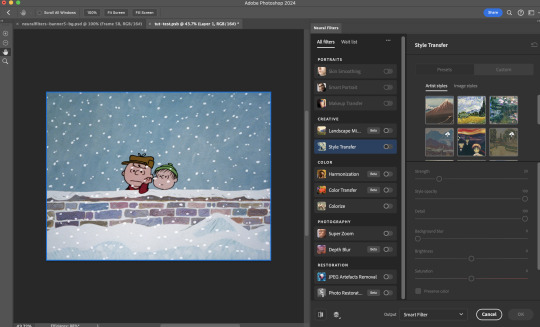
Installing Neural Filters:
Install the individual Neural Filters that you want to use. If the filter isn't installed, it will show a cloud symbol (highlighted in yellow). If the filter is already installed, it will show a toggle button (highlighted in green)
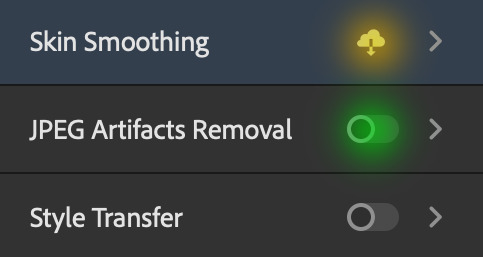
When you toggle this button, the Neural Filters preview window will look like this (where the toggle button next to the filter that you use turns blue)

4. Using Neural Filters
Once you have installed the Neural Filters that you want to use in your gif, you can toggle on a filter and play around with the sliders until you're satisfied. Here I'll walkthrough multiple concrete examples of how I use Neural Filters in my giffing process.
Example 1: Image enhancement | sample gifset
This is my typical Stage I Neural Filters gifmaking workflow. When giffing older or more niche media releases, my main concern is the video compression that leads to a lot of artefacts in the screencapped / video clipped gifs.
To fix the artefacts from compression, I go to Filter > Neural Filters, and toggle JPEG Artefacts Removal filter. Then I choose the strength of the filter (boxed in green), output this as a Smart Filter (boxed in yellow), and press OK (boxed in red).
Note: The filter has to be fully processed before you could press the OK button!
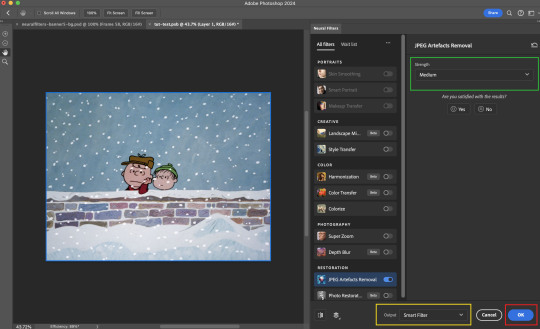
After applying the Neural Filters, you'll see "Neural Filters" under the Smart Filters property of the smart layer

Flatten / render your gif
Example 2: Facial enhancement | sample gifset
This is my routine use case during my Stage I Neural Filters gifmaking workflow. For musical artists (e.g. Maisie Peters), YouTube is often the only place where I'm able to find some videos to prepare gifs from. However even the highest resolution video available on YouTube is highly compressed.
Go to Filter > Neural Filters and toggle on Photo Restoration. If Photoshop recognises faces in the image, there will be a "Facial Enhancement" slider under the filter settings.

Play around with the Photo Enhancement & Facial Enhancement sliders. You can also expand the "Adjustment" menu make additional adjustments e.g. remove noises and reducing different types of artefacts.

Once you're happy with the results, press OK and then flatten / render your gif.
Example 3: Colour Manipulation | sample gifset
Want to make a colourful gifset but the source video is in B&W? This is where Colourise from Neural Filters comes in handy! This same colourising approach is also very helpful for colouring poor-lit scenes as detailed in this tutorial.
Here's a B&W gif that we want to colourise:

Highly recommended: add some adjustment layers onto the B&W gif to improve the contrast & depth. This will give you higher quality results when you colourise your gif.
Go to Filter > Neural Filters and toggle on Colourise.

Make sure "Auto colour image" is enabled.
Play around with further adjustments e.g. colour balance, until you're satisfied then press OK.
Important: When you colourise a gif, you need to double check that the resulting skin tone is accurate to real life. I personally go to Google Images and search up photoshoots of the individual / character that I'm giffing for quick reference.
Add additional adjustment layers until you're happy with the colouring of the skin tone.
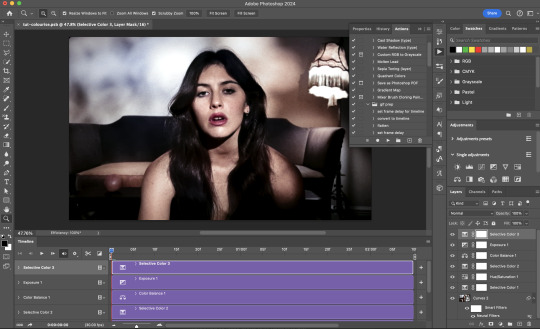
Once you're happy with the additional adjustments, flatten / render your gif. And voila!

Note: For Colour Manipulation, I use Colourise in my Stage I workflow and Colour Transfer in my Stage II workflow to do other types of colour manipulations (e.g. transforming the colour scheme of the component gifs)
Example 4: Artistic Effects | sample gifset
This is where I use Neural Filters for the bulk of my Stage II workflow: the most enjoyable stage in my editing process!
Normally I would be working with my big composition files with multiple component gifs inside it. To begin the fun, drag a component gif (in PSD file) to the main PSD composition file.
Resize this gif in the composition file until you're happy with the placement

Duplicate this gif. Sharpen the bottom layer (highlighted in yellow), and then select the top layer (highlighted in green) & go to Filter > Neural Filters

I like to use Style Transfer and Landscape Mixer to create artistic effects from Neural Filters. In this particular example, I've chosen Landscape Mixer
Select a preset or feed a custom image to the filter (here I chose a texture that I've on my computer)
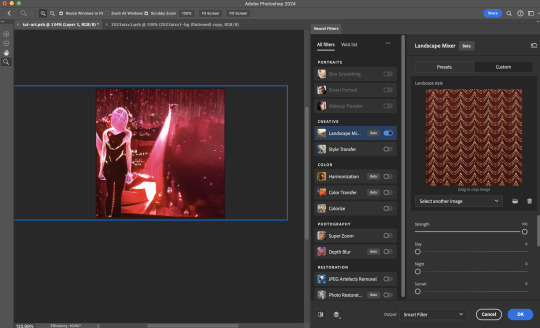
Play around with the different sliders e.g. time of the day / seasons
Important: uncheck "Harmonise Subject" & "Preserve Subject" - these two settings are known to cause performance issues when you render a multiframe smart object (e.g. for a gif)

Once you're happy with the artistic effect, press OK
To ensure you preserve the actual subject you want to gif (bc Preserve Subject is unchecked), add a layer mask onto the top layer (with Neural Filters) and mask out the facial region. You might need to play around with the Layer Mask Position keyframes or Rotoscope your subject in the process.
After you're happy with the masking, flatten / render this composition file and voila!

Example 5: Putting it all together | sample gifset
Let's recap on the Neural Filters gifmaking workflow and where Stage I and Stage II fit in my gifmaking process:
i. Preparing & enhancing the component gifs
Prepare all component gifs and convert them to smart layers
Stage I: Add base colourings & apply Photo Restoration / JPEG Artefacts Removal to enhance the gif's image quality
Flatten all of these component gifs and convert them back to Smart Video Layers (this process can take a lot of time)
Some of these enhanced gifs will be Rotoscoped so this is done before adding the gifs to the big PSD composition file
ii. Setting up the big PSD composition file
Make a separate PSD composition file (Ctrl / Cmmd + N) that's of Tumblr dimension (e.g. 540px in width)
Drag all of the component gifs used into this PSD composition file
Enable Video Timeline and trim the work area
In the composition file, resize / move the component gifs until you're happy with the placement & sharpen these gifs if you haven't already done so
Duplicate the layers that you want to use Neural Filters on
iii. Working with Neural Filters in the PSD composition file
Stage II: Neural Filters to create artistic effects / more colour manipulations!
Mask the smart layers with Neural Filters to both preserve the subject and avoid colouring issues from the filters
Flatten / render the PSD composition file: the more component gifs in your composition file, the longer the exporting will take. (I prefer to render the composition file into a .mov clip to prevent overriding a file that I've spent effort putting together.)
Note: In some of my layout gifsets (where I've heavily used Neural Filters in Stage II), the rendering time for the panel took more than 20 minutes. This is one of the rare instances where I was maxing out my computer's memory.
Useful things to take note of:
Important: If you're using Neural Filters for Colour Manipulation or Artistic Effects, you need to take a lot of care ensuring that the skin tone of nonwhite characters / individuals is accurately coloured
Use the Facial Enhancement slider from Photo Restoration in moderation, if you max out the slider value you risk oversharpening your gif later on in your gifmaking workflow
You will get higher quality results from Neural Filters by working with larger image dimensions: This gives Neural Filters more pixels to work with. You also get better quality results by feeding higher resolution reference images to the Neural Filters.
Makeup Transfer is more stable when the person / character has minimal motion in your gif
You might get unexpected results from Landscape Mixer if you feed a reference image that don't feature a distinctive landscape. This is not always a bad thing: for instance, I have used this texture as a reference image for Landscape Mixer, to create the shimmery effects as seen in this gifset
5. Testing your system
If this is the first time you're applying Neural Filters directly onto a gif, it will be helpful to test out your system yourself. This will help:
Gauge the expected rendering time that you'll need to wait for your gif to export, given specific Neural Filters that you've used
Identify potential performance issues when you render the gif: this is important and will determine whether you will need to fully playback your gif before flattening / rendering the file.
Understand how your system's resources are being utilised: Inputs from Windows PC users & Mac users alike are welcome!
About the Neural Filters test files:
Contains six distinct files, each using different Neural Filters
Two sizes of test files: one copy in full HD (1080p) and another copy downsized to 540px
One folder containing the flattened / rendered test files
How to use the Neural Filters test files:
What you need:
Photoshop 2022 or newer (recommended: 2023 or later)
Install the following Neural Filters: Landscape Mixer / Style Transfer / Colour Transfer / Colourise / Photo Restoration / Depth Blur
Recommended for some Apple Silicon-based MacBook Pro models: Enable High Power Mode
How to use the test files:
For optimal performance, close all background apps
Open a test file
Flatten the test file into frames (load this action pack & play the “flatten” action)
Take note of the time it takes until you’re directed to the frame animation interface
Compare the rendered frames to the expected results in this folder: check that all of the frames look the same. If they don't, you will need to fully playback the test file in full before flattening the file.†
Re-run the test file without the Neural Filters and take note of how long it takes before you're directed to the frame animation interface
Recommended: Take note of how your system is utilised during the rendering process (more info here for MacOS users)
†This is a performance issue known as flickering that I will discuss in the next section. If you come across this, you'll have to playback a gif where you've used Neural Filters (on the video timeline) in full, prior to flattening / rendering it.
Factors that could affect the rendering performance / time (more info):
The number of frames, dimension, and colour bit depth of your gif
If you use Neural Filters with facial recognition features, the rendering time will be affected by the number of characters / individuals in your gif
Most resource intensive filters (powered by largest machine learning models): Landscape Mixer / Photo Restoration (with Facial Enhancement) / and JPEG Artefacts Removal
Least resource intensive filters (smallest machine learning models): Colour Transfer / Colourise
The number of Neural Filters that you apply at once / The number of component gifs with Neural Filters in your PSD file
Your system: system memory, the GPU, and the architecture of the system's CPU+++
+++ Rendering a gif with Neural Filters demands a lot of system memory & GPU horsepower. Rendering will be faster & more reliable on newer computers, as these systems have CPU & GPU with more modern instruction sets that are geared towards machine learning-based tasks.
Additionally, the unified memory architecture of Apple Silicon M-series chips are found to be quite efficient at processing Neural Filters.
6. Performance issues & workarounds
Common Performance issues:
I will discuss several common issues related to rendering or exporting a multi-frame smart object (e.g. your composite gif) that uses Neural Filters below. This is commonly caused by insufficient system memory and/or the GPU.
Flickering frames: in the flattened / rendered file, Neural Filters aren't applied to some of the frames+-+
Scrambled frames: the frames in the flattened / rendered file isn't in order
Neural Filters exceeded the timeout limit error: this is normally a software related issue
Long export / rendering time: long rendering time is expected in heavy workflows
Laggy Photoshop / system interface: having to wait quite a long time to preview the next frame on the timeline
Issues with Landscape Mixer: Using the filter gives ill-defined defined results (Common in older systems)--
Workarounds:
Workarounds that could reduce unreliable rendering performance & long rendering time:
Close other apps running in the background
Work with smaller colour bit depth (i.e. 8-bit rather than 16-bit)
Downsize your gif before converting to the video timeline-+-
Try to keep the number of frames as low as possible
Avoid stacking multiple Neural Filters at once. Try applying & rendering the filters that you want one by one
Specific workarounds for specific issues:
How to resolve flickering frames: If you come across flickering, you will need to playback your gif on the video timeline in full to find the frames where the filter isn't applied. You will need to select all of the frames to allow Photoshop to reprocess these, before you render your gif.+-+
What to do if you come across Neural Filters timeout error? This is caused by several incompatible Neural Filters e.g. Harmonisation (both the filter itself and as a setting in Landscape Mixer), Scratch Reduction in Photo Restoration, and trying to stack multiple Neural Filters with facial recognition features.
If the timeout error is caused by stacking multiple filters, a feasible workaround is to apply the Neural Filters that you want to use one by one over multiple rendering sessions, rather all of them in one go.
+-+This is a very common issue for Apple Silicon-based Macs. Flickering happens when a gif with Neural Filters is rendered without being previously played back in the timeline.
This issue is likely related to the memory bandwidth & the GPU cores of the chips, because not all Apple Silicon-based Macs exhibit this behaviour (i.e. devices equipped with Max / Ultra M-series chips are mostly unaffected).
-- As mentioned in the supplementary page, Landscape Mixer requires a lot of GPU horsepower to be fully rendered. For older systems (pre-2017 builds), there are no workarounds other than to avoid using this filter.
-+- For smaller dimensions, the size of the machine learning models powering the filters play an outsized role in the rendering time (i.e. marginal reduction in rendering time when downsizing 1080p file to Tumblr dimensions). If you use filters powered by larger models e.g. Landscape Mixer and Photo Restoration, you will need to be very patient when exporting your gif.
7. More useful resources on using Neural Filters
Creating animations with Neural Filters effects | Max Novak
Using Neural Filters to colour correct by @edteachs
I hope this is helpful! If you have any questions or need any help related to the tutorial, feel free to send me an ask 💖
#photoshop tutorial#gif tutorial#dearindies#usernik#useryoshi#usershreyu#userisaiah#userroza#userrobin#userraffa#usercats#userriel#useralien#userjoeys#usertj#alielook#swearphil#*#my resources#my tutorials
509 notes
·
View notes
Text
I am somewhat loving the Y2K/Crowdstrike comparisons, but that general idea did bring something to mind:
The only reason Y2K didn't end up being a thing is because programmers worked for like a decade to fix code. My mom worked for a small software company in the late-80s and early-90s, and she said that they were discussing a game plan for Y2K by like 1992. And I just feel like that sort of care and foresight with technology has evaporated in such a short period of time.
Making everything cloud-based has resulted in incomplete products being pushed into production because they can always be patched or updated later, but companies want the dollars the purchases will bring in now. And, I'm not saying that's what caused the Crowdstrike thing. But I do think the "We can just push an update sometime" attitude has caused a lot of loosening of standards when it comes to software and online services. Customers are acting as unwilling beta testers for products and services that, in the past, would have been fully tested before going into production, and it is 1000% driven by greed and need for immediate profitability and remaining on the cutting edge of technology rather than a sustainable business model based around quality products.
I'm not even entirely sure what I'm rambling about. I just hate that I feel like in my short 36 years on this planet, I've somehow seen technology at its best evolve into technology at its worst over a period of maybe two decades. It bums me out.
207 notes
·
View notes
Text
afterglow

Series Warnings: Language, alcohol and drinking. Military inaccuracies. Allusions to and eventual smut. Friends to lovers. Mutual pining. Unrequited love. Minors DNI. 18+. Banner Credit: @thedroneranger
Masterlist Previous Part Next Part
...........................................
Chapter 1: In My Head
The week passed in a blur of jets and clouds and sunshine. By Thursday, you were finally able to choke down the feelings you had for Jake, just in time for him to wreck them on Friday.
As the squadron sat in the briefing room Thursday evening, Cyclone came in, whispered something to Maverick, and then left.
"Well, folks, it looks like we need someone to make a late afternoon flight before they head home to test out some new software. Any takers?" Maverick asked.
There was a collective groan before Jake's hang shot up. "Glow and I can." He volunteered the two of you with a smile. He knew that you loved flying in the afternoon as the sun was starting to set. You always had.
"Are you okay with that, Glow?" Maverick asked you. "Yes, sir," you responded. Maverick sent everyone else home for the day. He met the two of you out on the tarmac to prep you for what you would be doing.
"Also, Admiral Simpson said whoever stayed late today could have tomorrow off. So, it looks like you two get a three day weekend." Maverick smiled at the pair of you. You and Jake exchanged a high- five before he helped you up and got himself situated.
The evening sky was absolutely beautiful as the two of you flew. The sun painted it in shades of pinks and oranges, and purples. The hues danced off the water and floated around the jet. You couldn't help but smile as Jake piloted back towards base.
"I can see why this is your favorite time to be up here." He said to you. "It's gorgeous."
"It is. There is just something about the afterglow that always gets me." You told him. And you meant it. In more ways than one.
After landing, showering, and changing, you ducked out of the locker room to find Jake leaning against the wall waiting on you. "Oh!" You exclaimed when you saw him. "I thought you would have already left by now."
"I was waiting on you, silly." He smiled before falling in step beside you. He lazily tossed an arm over your shoulders as you walked. His hair was still slightly damp, and you could smell his cologne. The scent of oak, whiskey, and tobacco filled your olfactory receptors. It was mixed with a hint of sunshine and salt water. A combination that was so perfect, so unique, so—Jake.
"So I was thinking." Jake began. "That's terrifying." You snorted. He lightly shoved you before pulling you back to him. "But seriously. I don't have any pressing issues I need to take care of tomorrow, and I assume you don't. So, I was thinking, what if we spent the day together?" Jake asked you as you reached your cars in the parking lot.
"And do what?" You asked him. "'We could get breakfast at that diner you love, and we could take the tops off of your jeep and cruise for a bit to our favorite ice cream place, hit the beach, get dinner, oh and Phoenix told me about the movie she and Lukas saw over the weekend. I thought we would check it out and maybe skip the Hard Deck because I, for one, don't want to hear Rooster bitching about how we got the day off." Jake smiled. He had the whole thing planned out.
"So? What do you think?" He asked you with a smile.
You knew this was a bad idea. If you were up in the jet, you'd have warning lights going off everywhere, and you'd be ejecting. "Sounds like a plan. What time do I need to pick you up if we are taking my car?" You asked him.
"Now, Glowy, you no good and well that I'm not going to let you pick me up." I'll be at your house at 9:30 sharp." He stated. You rolled your eyes and agreed. Jake pulled you into a tight hug before climbing into his Silverado and leaving.
....................
You set your alarm for 6:30 the next morning. Even though he said he would be there around 9:30, Jake Seresin was notoriously early for everything.
You got up and took a shower before drying and styling your hair. You took your time dawning some simple makeup for the day. After your finished with your hair and your face, you packed a bag for the day.
You grabbed towels, sunscreen, a change of clothes, some snacks and a few other odds and ends that you thought you might need.
Jake had mentioned the beach, so you slipped a simple purple two-piece on before deciding on a tea-length, bright pink floral sundress. You slipped on a pair of sandals and spritzed your favorite perfume on your wrists and neck.
You were giddy as you were getting ready. You had to keep reminding yourself that this wasn't a date. Just two friends enjoying an unexpected day off.
At nine on the dot, there was a knock at your door. "Good morning, Jake." You greeted him as you opened it. "Morning Y/N. I brought coffee and these." Jake smiled as he walked in. He handed you your favorite iced carmel latte and a bundle of fresh daisies. "They're your favorite, right?" He nodded to the flowers.
"Yeah, um—why did you get me these?" You ask him a little confused.
"My mother told me you never go to a lady's house without flowers." Jake stated matter of factly. "Plus, the farmers market is right near the coffee shop, and I saw these and thought of you." He smiled.
You quickly turned away from him to find a vase. You wouldn't let him see the pink rise in your cheeks.
After securing the flowers, he promptly stole the keys from their hook in your hallway and pulled the tops off of your jeep. He secured them in your garage. The weather was supposed to be bright and sunny all day, so you didn't bother storing them in the trunk.
You tried to argue with him that you should be the one driving, but he simply shook his head stating thst he was the pilot and you would forever be his back seater, or in this case, passenger princess.
..................
The weather was spectacular as the two of you drove to your favorite diner. You laughed and joked as the two of you feasted on bacon, eggs, potatoes, and French toast.
"I'm so glad that I got orders to come here. Lemoore sucked without you. The pilot they assigned to me after you got recalled was even more of a dick than you." You told Jake as you speared a potato square.
"Really? I doubt that." He chuckled. "And it is great that you got moved here." He smiled. Jake prayed you didn't catch the guilt behind his eyes.
It was no accident that you ended up in San Diego with him.
When pilots were being recalled for the uranium plant mission, the rule was that no pairs of pilots and their weapons systems officers could be called together. They didn't want to leave the original squadrons hanging for too long. That's why Jake flew a singe seater. He refused to have anyone in his back seat besides you.
It killed him to leave you. So, after getting word that he would be permanently stationed at Top Gun, he begged asked Cyclone and Warlock if they could transfer you, and he could get back in a two-seater.
Admiral Simpson and Admiral Bates reluctantly agreed, but it worked out for the better. Jake was much more tolerable with you around.
After you finished breakfast, Jake swiped the bill before you could set your card down, claiming once again that his mother would have his head if he let a lady pay. You had to take a deep breath and remind yourself that this wasn't a date.
You silenced the warning bells once again before getting into your car.
The two of you drove along the coast, stopping at a few shops and sent selfies to the rest of your friends who were stuck at work.
You had ice cream on the boardwalk for lunch. The two of you sat side by side and watched the waves roll in. Jake had asked you something, and when you turned to answer, he noticed you at the smallest smear of mint chip on your face. He leaned in with his thumb to brush it away, but he lingered before pulling back. His eyes darted to your lips, and he leaned forward ever so slightly.
The caution lights flashed before your eyes. No, he wasn't about to kiss you. Not here. Not out in the open like this. Your brain was screaming at you to eject.
You pulled away from him and cleared your throat. He pulled back and coughed before licking the melted ice cream from his thumb.
"So, beach?" You asked him after a beat of silence.
"Yeah, beach" He nodded.
The two of you tossed your cones before going back to your car and grabbing the beach bag you'd packed. You slipped off your sundress, and Jake's breath caught in his throat when he saw you in your purple swimsuit. His was barely able to keep his tough guy charade up as he helped you apply sunscreen.
The two of you froliced through the waves, splashing and laughing until the sun began to sink. After a quick use of the beach showers and a pit stop in the changing room, both of you were relatively sand free as you sat back in your car. You'd pulled your hair into a high ponytail and were humming along to the music as Jake drove the two of you towards the movie theater.
After getting more popcorn and candy than necessary, and two icees that would give you the worst brain freeze ever, the two of you found yourselves in the last row of an almost empty theater.
Jake had moved the armrest separating your seats out of the way, claiming it was easier to share snacks that way. But you didn't miss the way his bare knee bumped against yours through the slit of your sundress.
..................
At the Hard Deck, the rest of the Daggers finally concluded that the two of you probably weren't showing up tonight.
"It's not fair," Fanboy groaned as he leaned over the pool table.
"I mean, they did volunteer to take a later test flight yesterday, so it is kind of fair." Bob shrugged.
"Bob is right. We all had the same opportunity." Payback stated.
"So what do you think they are doing that is better than hanging out with us?" Coyote asked the group.
"Probably fucking." Rooster shrugged causing half of the group to choke on their drinks.
"Jesus, Bradshaw. Have some tact, man." Payback scolded him.
"What, I'm just saying what we are all thinking." Rooster defended himself. "Glow assures me that they are just friends. Very good friends." Phoenix tells the group.
"Yeah, and I'm a front seater." Fanboy laughed.
"Nix, you can't really believe that. I mean, haven't you seen they way they look at each other? Or noticed how they always leave together from here? And they are together right now?" Rooster pressed.
"Rooster does have a point." Bob chimed in.
"So I have a theory, well three, of what the situation could be." Payback began. "I'm going to present them in order from least plausible to most likely." He continued.
"One, they are secretly dating or maybe married. That would explain why she got transferred to here from Lemoore. Two, they really are just good friends and have worked together so long that they act like a couple. Or, three, and what I feel is most likely, they are hooking up, and one of them, Hangman, wants to keep it more casual, while ignoring the fact that the other, Glow, has feelings for him." Payback finished.
"Well, I don't know what it is. All I know is that Hangman is way easier to deal with when she's around." Phoenix said as she held up her beer. Everyone mumbled out an agreement as they went about their pool game.
.................
Nat was right. The movie was great, and you were glad you had seen it.
You and Jake were walking back to your car as the last rays of the sun began to dip below the horizon.
"Ugh, the sunsets here are so much prettier than the ones in Lemoore." You told Jake.
"Yeah, they are." He agreed with you. "Looks like some clouds are rolling in. We'd better get a move on." He said. You took note of the weather and agreed. You definitely didn't want to get caught in the rain with no cover on your jeep.
Unfortunately, Mother Nature had other plans. The two of you were about halfway back to your house when the heavens opened up and rain came pouring down. Jake desperately tried to find an overpass for shelter, but there was nothing in sight.
He broke a few traffic laws to get you home, sliding into your garage on two wheels. The two of you sat there for a moment, soaking wet and out of breath.
You shared a look before breaking out into a laugh.
As the laughter faded, the air shifted between the you. The electricity flowing wasn't just the lightening from the storm. Desire radiated off your bodies as you both surged forward and connected your lips.
You basked in the salty, sweet taste of him, as you tried to ignore the warning bells going off. But eventually, you gave in and pulled away from him.
"We can't keep doing this, Jake." You told him.
"I know." He replied as he cupped your jaw, dragging his lips almost criminally slow against your skin. You could feel the subtle hint of the stubble on his chin.
Heat flushed in your cheeks and spread across you from the tips of your ears to the curl of your toes. You felt like you were doused in gasoline, and his touch was the strike of the match, ready to burn you down.
"One last time?" You breathed out.
"One last time." He whispered against the shell of your ear.
Taglist: @thedroneranger @roosterscock @shanimallina87 @desert-fern @teacupsandtopgun @mayhemmanaged @lovinglyeternal @lovingbradshawafterdark @wkndwlff @roosterforme @daggerspare-standingby @dakotakazansky @startrekfangirl2233 @hecate-steps-on-me @cassiemitchell @na-ta-sh-aa @milestellerlover @katieshook02 @mak-32 @je-suis-prest-rachel @soulmates8 @ohgodnotagainn @diorrfairy @eli2447 @xoxabs88xox @potato-girl99981 @djs8891 @roosterbruiser @roosters-girl @sebsxphia @roostette @rosiahills22 @dempy @olliepig
#cherrycola27#top gun#top gun maverick#tgm#tgm fic#tgm fanfiction#tgm smut#lt. jake seresin#jake seresin smut#jake seresin#jake seresin x reader#jake hangman seresin#hangman seresin#hangman top gun#top gun hangman#hangman smut#top gun 2#afterglow
279 notes
·
View notes
Text
Hire Dedicated Developers in India Smarter with AI
Hire dedicated developers in India smarter and faster with AI-powered solutions. As businesses worldwide turn to software development outsourcing, India remains a top destination for IT talent acquisition. However, finding the right developers can be challenging due to skill evaluation, remote team management, and hiring efficiency concerns. Fortunately, AI recruitment tools are revolutionizing the hiring process, making it seamless and effective.
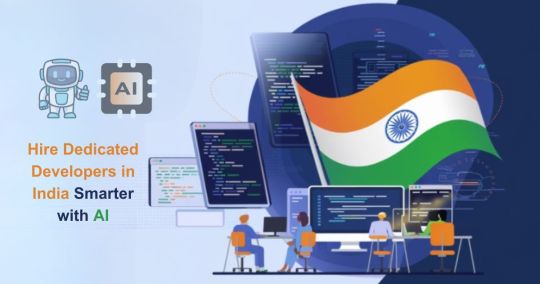
In this blog, I will explore how AI-powered developer hiring is transforming the recruitment landscape and how businesses can leverage these tools to build top-notch offshore development teams.
Why Hire Dedicated Developers in India?
1) Cost-Effective Without Compromising Quality:
Hiring dedicated developers in India can reduce costs by up to 60% compared to hiring in the U.S., Europe, or Australia. This makes it a cost-effective solution for businesses seeking high-quality IT staffing solutions in India.
2) Access to a Vast Talent Pool:
India has a massive talent pool with millions of software engineers proficient in AI, blockchain, cloud computing, and other emerging technologies. This ensures companies can find dedicated software developers in India for any project requirement.
3) Time-Zone Advantage for 24/7 Productivity:
Indian developers work across different time zones, allowing continuous development cycles. This enhances productivity and ensures faster project completion.
4) Expertise in Emerging Technologies:
Indian developers are highly skilled in cutting-edge fields like AI, IoT, and cloud computing, making them invaluable for innovative projects.
Challenges in Hiring Dedicated Developers in India
1) Finding the Right Talent Efficiently:
Sorting through thousands of applications manually is time-consuming. AI-powered recruitment tools streamline the process by filtering candidates based on skill match and experience.
2) Evaluating Technical and Soft Skills:
Traditional hiring struggles to assess real-world coding abilities and soft skills like teamwork and communication. AI-driven hiring processes include coding assessments and behavioral analysis for better decision-making.
3) Overcoming Language and Cultural Barriers:
AI in HR and recruitment helps evaluate language proficiency and cultural adaptability, ensuring smooth collaboration within offshore development teams.
4) Managing Remote Teams Effectively:
AI-driven remote work management tools help businesses track performance, manage tasks, and ensure accountability.
How AI is Transforming Developer Hiring
1. AI-Powered Candidate Screening:
AI recruitment tools use resume parsing, skill-matching algorithms, and machine learning to shortlist the best candidates quickly.
2. AI-Driven Coding Assessments:
Developer assessment tools conduct real-time coding challenges to evaluate technical expertise, code efficiency, and problem-solving skills.
3. AI Chatbots for Initial Interviews:
AI chatbots handle initial screenings, assessing technical knowledge, communication skills, and cultural fit before human intervention.
4. Predictive Analytics for Hiring Success:
AI analyzes past hiring data and candidate work history to predict long-term success, improving recruitment accuracy.
5. AI in Background Verification:
AI-powered background checks ensure candidate authenticity, education verification, and fraud detection, reducing hiring risks.
Steps to Hire Dedicated Developers in India Smarter with AI
1. Define Job Roles and Key Skill Requirements:
Outline essential technical skills, experience levels, and project expectations to streamline recruitment.
2. Use AI-Based Hiring Platforms:
Leverage best AI hiring platforms like LinkedIn Talent Insightsand HireVue to source top developers.
3. Implement AI-Driven Skill Assessments:
AI-powered recruitment processes use coding tests and behavioral evaluations to assess real-world problem-solving abilities.
4. Conduct AI-Powered Video Interviews:
AI-driven interview tools analyze body language, sentiment, and communication skills for improved hiring accuracy.
5. Optimize Team Collaboration with AI Tools:
Remote work management tools like Trello, Asana, and Jira enhance productivity and ensure smooth collaboration.
Top AI-Powered Hiring Tools for Businesses
LinkedIn Talent Insights — AI-driven talent analytics
HackerRank — AI-powered coding assessments
HireVue — AI-driven video interview analysis
Pymetrics — AI-based behavioral and cognitive assessments
X0PA AI — AI-driven talent acquisition platform
Best Practices for Managing AI-Hired Developers in India
1. Establish Clear Communication Channels:
Use collaboration tools like Slack, Microsoft Teams, and Zoom for seamless communication.
2. Leverage AI-Driven Productivity Tracking:
Monitor performance using AI-powered tracking tools like Time Doctor and Hubstaff to optimize workflows.
3. Encourage Continuous Learning and Upskilling:
Provide access to AI-driven learning platforms like Coursera and Udemy to keep developers updated on industry trends.
4. Foster Cultural Alignment and Team Bonding:
Organize virtual team-building activities to enhance collaboration and engagement.
Future of AI in Developer Hiring
1) AI-Driven Automation for Faster Hiring:
AI will continue automating tedious recruitment tasks, improving efficiency and candidate experience.
2) AI and Blockchain for Transparent Recruitment:
Integrating AI with blockchain will enhance candidate verification and data security for trustworthy hiring processes.
3) AI’s Role in Enhancing Remote Work Efficiency:
AI-powered analytics and automation will further improve productivity within offshore development teams.
Conclusion:
AI revolutionizes the hiring of dedicated developers in India by automating candidate screening, coding assessments, and interview analysis. Businesses can leverage AI-powered tools to efficiently find, evaluate, and manage top-tier offshore developers, ensuring cost-effective and high-quality software development outsourcing.
Ready to hire dedicated developers in India using AI? iQlance offers cutting-edge AI-powered hiring solutions to help you find the best talent quickly and efficiently. Get in touch today!
#AI#iqlance#hire#india#hirededicatreddevelopersinIndiawithAI#hirededicateddevelopersinindia#aipoweredhiringinindia#bestaihiringtoolsfordevelopers#offshoresoftwaredevelopmentindia#remotedeveloperhiringwithai#costeffectivedeveloperhiringindia#aidrivenrecruitmentforitcompanies#dedicatedsoftwaredevelopersindia#smarthiringwithaiinindia#aipowereddeveloperscreening
5 notes
·
View notes
Text
AI & Tech-Related Jobs Anyone Could Do
Here’s a list of 40 jobs or tasks related to AI and technology that almost anyone could potentially do, especially with basic training or the right resources:
Data Labeling/Annotation
AI Model Training Assistant
Chatbot Content Writer
AI Testing Assistant
Basic Data Entry for AI Models
AI Customer Service Representative
Social Media Content Curation (using AI tools)
Voice Assistant Testing
AI-Generated Content Editor
Image Captioning for AI Models
Transcription Services for AI Audio
Survey Creation for AI Training
Review and Reporting of AI Output
Content Moderator for AI Systems
Training Data Curator
Video and Image Data Tagging
Personal Assistant for AI Research Teams
AI Platform Support (user-facing)
Keyword Research for AI Algorithms
Marketing Campaign Optimization (AI tools)
AI Chatbot Script Tester
Simple Data Cleansing Tasks
Assisting with AI User Experience Research
Uploading Training Data to Cloud Platforms
Data Backup and Organization for AI Projects
Online Survey Administration for AI Data
Virtual Assistant (AI-powered tools)
Basic App Testing for AI Features
Content Creation for AI-based Tools
AI-Generated Design Testing (web design, logos)
Product Review and Feedback for AI Products
Organizing AI Training Sessions for Users
Data Privacy and Compliance Assistant
AI-Powered E-commerce Support (product recommendations)
AI Algorithm Performance Monitoring (basic tasks)
AI Project Documentation Assistant
Simple Customer Feedback Analysis (AI tools)
Video Subtitling for AI Translation Systems
AI-Enhanced SEO Optimization
Basic Tech Support for AI Tools
These roles or tasks could be done with minimal technical expertise, though many would benefit from basic training in AI tools or specific software used in these jobs. Some tasks might also involve working with AI platforms that automate parts of the process, making it easier for non-experts to participate.
3 notes
·
View notes
Text
AI Agent Development: How to Create Intelligent Virtual Assistants for Business Success
In today's digital landscape, businesses are increasingly turning to AI-powered virtual assistants to streamline operations, enhance customer service, and boost productivity. AI agent development is at the forefront of this transformation, enabling companies to create intelligent, responsive, and highly efficient virtual assistants. In this blog, we will explore how to develop AI agents and leverage them for business success.

Understanding AI Agents and Virtual Assistants
AI agents, or intelligent virtual assistants, are software programs that use artificial intelligence, machine learning, and natural language processing (NLP) to interact with users, automate tasks, and make decisions. These agents can be deployed across various platforms, including websites, mobile apps, and messaging applications, to improve customer engagement and operational efficiency.
Key Features of AI Agents
Natural Language Processing (NLP): Enables the assistant to understand and process human language.
Machine Learning (ML): Allows the assistant to improve over time based on user interactions.
Conversational AI: Facilitates human-like interactions.
Task Automation: Handles repetitive tasks like answering FAQs, scheduling appointments, and processing orders.
Integration Capabilities: Connects with CRM, ERP, and other business tools for seamless operations.
Steps to Develop an AI Virtual Assistant
1. Define Business Objectives
Before developing an AI agent, it is crucial to identify the business goals it will serve. Whether it's improving customer support, automating sales inquiries, or handling HR tasks, a well-defined purpose ensures the assistant aligns with organizational needs.
2. Choose the Right AI Technologies
Selecting the right technology stack is essential for building a powerful AI agent. Key technologies include:
NLP frameworks: OpenAI's GPT, Google's Dialogflow, or Rasa.
Machine Learning Platforms: TensorFlow, PyTorch, or Scikit-learn.
Speech Recognition: Amazon Lex, IBM Watson, or Microsoft Azure Speech.
Cloud Services: AWS, Google Cloud, or Microsoft Azure.
3. Design the Conversation Flow
A well-structured conversation flow is crucial for user experience. Define intents (what the user wants) and responses to ensure the AI assistant provides accurate and helpful information. Tools like chatbot builders or decision trees help streamline this process.
4. Train the AI Model
Training an AI assistant involves feeding it with relevant datasets to improve accuracy. This may include:
Supervised Learning: Using labeled datasets for training.
Reinforcement Learning: Allowing the assistant to learn from interactions.
Continuous Learning: Updating models based on user feedback and new data.
5. Test and Optimize
Before deployment, rigorous testing is essential to refine the AI assistant's performance. Conduct:
User Testing: To evaluate usability and responsiveness.
A/B Testing: To compare different versions for effectiveness.
Performance Analysis: To measure speed, accuracy, and reliability.
6. Deploy and Monitor
Once the AI assistant is live, continuous monitoring and optimization are necessary to enhance user experience. Use analytics to track interactions, identify issues, and implement improvements over time.
Benefits of AI Virtual Assistants for Businesses
1. Enhanced Customer Service
AI-powered virtual assistants provide 24/7 support, instantly responding to customer queries and reducing response times.
2. Increased Efficiency
By automating repetitive tasks, businesses can save time and resources, allowing employees to focus on higher-value tasks.
3. Cost Savings
AI assistants reduce the need for large customer support teams, leading to significant cost reductions.
4. Scalability
Unlike human agents, AI assistants can handle multiple conversations simultaneously, making them highly scalable solutions.
5. Data-Driven Insights
AI assistants gather valuable data on customer behavior and preferences, enabling businesses to make informed decisions.
Future Trends in AI Agent Development
1. Hyper-Personalization
AI assistants will leverage deep learning to offer more personalized interactions based on user history and preferences.
2. Voice and Multimodal AI
The integration of voice recognition and visual processing will make AI assistants more interactive and intuitive.
3. Emotional AI
Advancements in AI will enable virtual assistants to detect and respond to human emotions for more empathetic interactions.
4. Autonomous AI Agents
Future AI agents will not only respond to queries but also proactively assist users by predicting their needs and taking independent actions.
Conclusion
AI agent development is transforming the way businesses interact with customers and streamline operations. By leveraging cutting-edge AI technologies, companies can create intelligent virtual assistants that enhance efficiency, reduce costs, and drive business success. As AI continues to evolve, embracing AI-powered assistants will be essential for staying competitive in the digital era.
4 notes
·
View notes
Text
The Biden administration is asking the world’s largest technology companies to publicly commit to tightening the digital security of their software and cloud services.
The voluntary pledge, first reported by WIRED, represents the latest effort by the Department of Homeland Security’s Cybersecurity and Infrastructure Security Agency (CISA) to build support for its Secure by Design initiative, which encourages tech vendors to prioritize cybersecurity while developing and configuring their products.
By signing the pledge, companies promise to make a “good-faith effort” to implement seven critical cybersecurity improvements, ranging from soliciting reports of vulnerabilities in their products to expanding the use of multi-factor authentication, a technology that adds an extra login step to the traditional password.
The pledge—which CISA plans to announce at the RSA cybersecurity conference in San Francisco next week—poses a major test for CISA, which last week marked the one-year anniversary of its Secure by Design campaign. The initiative is a top priority of CISA’s leadership, but it has produced mixed results, with some companies continuing to flout its urgent advice. The tech industry’s reaction to the pledge—and especially the number of software giants that sign it—will serve as a litmus test for how the private sector views CISA’s continuing push for increased corporate investment in cybersecurity.
“We're really excited about the companies that are on board,” Eric Goldstein, CISA’s executive assistant director for cybersecurity, tells WIRED. He declined to say how many vendors have already signed the pledge, but he says they include some “really significant” players in the tech industry.
WIRED asked more than three dozen of the biggest software companies whether they had signed or planned to sign the pledge. Only a handful responded. Login technology provider Okta said it had signed, while security vendor BlackBerry said it was considering doing so. Notably, software giants Amazon, Google, and Microsoft did not say whether they were signing.
“CISA says they have 50 companies that are signing and giving quotations to put on the website,” says a tech industry official familiar with the matter, who requested anonymity to speak candidly. “I don’t know any company that has signed.”
The seven goals laid out in the pledge represent security practices that experts say would dramatically improve companies’ cyberdefenses and make it easier for customers to safely use their products.
The goals include significantly increasing users’ use of multi-factor authentication, including by automatically enabling it or prodding users to activate it; eliminating default passwords, including by requiring users to choose strong passwords at product setup; and making it easier for customers to understand hacks of products they use, including by letting them review logs of suspicious network activity for free.
Companies signing the pledge would also commit to hardening their products against entire classes of vulnerabilities, such as by using memory-safe programming languages that completely block memory-based attacks; fostering better software patching, including by making patching easier and automating it when possible; creating vulnerability disclosure programs that encourage users to find and report product flaws; and publishing timely alerts about major new vulnerabilities, as well as including detailed information in all new vulnerability alerts.
The pledge offers examples of how companies can meet the goals, although it notes that companies “have the discretion to decide how best” to do so. The document also emphasizes the importance of companies publicly demonstrating “measurable progress” on their goals, as well as documenting their techniques “so that others can learn.”
CISA developed the pledge in consultation with tech companies, seeking to understand what would be feasible for them while also meeting the agency’s goals, according to Goldstein. That meant making sure the commitments were feasible for companies of all sizes, not just Silicon Valley giants.
The agency originally tried using its Joint Cyber Defense Collaborative to prod companies into signing the pledge, according to the tech industry official, but that backfired when companies questioned the use of an operational cyberdefense collaboration group for “a policy and legal issue,” the industry official says.
“Industry expressed frustration about trying to use the JCDC to obtain pledges,” the official says, and CISA “wisely pulled back on that effort.”
CISA then held discussions with companies through the Information Technology Sector Coordinating Council and tweaked the pledge based on their feedback. Originally, the pledge contained more than seven goals, and CISA wanted signatories to commit to “firm metrics” for showing progress, according to the industry official. In the end, this person says, CISA removed several goals and “broadened the language” about measuring progress.
John Miller, senior vice president of policy, trust, data, and technology at the Information Technology Industry Council, a major industry trade group, says that change was smart, because concrete progress metrics—like the number of users using multi-factor authentication—could be “easily misconstrued.”
Goldstein says the number of pledge signatories is “exceeding my expectations about where we’d be” at this point. The industry official says they’re not aware of any company that has definitively refused to sign the pledge, in part because vendors want to “keep open the option of signing on” after CISA’s launch event at RSA. “Everyone’s in a kind of wait-and-see mode.”
Legal liability is a top concern for potential signatory companies. “If there ends up being, inevitably, some type of security incident,” Miller says, “anything [a] company has said publicly could be used in lawsuits.”
That said, Miller predicts that some global companies facing strict new European security requirements will sign the US pledge to “get that credit” for something they already have to do.
CISA’s Secure by Design campaign is the centerpiece of the Biden administration’s ambitious plan to shift the burden of cybersecurity from users to vendors, a core theme of the administration’s National Cybersecurity Strategy. The push for corporate cyber responsibility follows years of disruptive supply-chain attacks on critical software makers like Microsoft, SolarWinds, Kaseya, and Change Healthcare, as well as a mounting list of widespread software vulnerabilities that have powered ransomware attacks on schools, hospitals, and other essential services. White House officials say the pattern of costly and often preventable breaches demonstrates the need for increased corporate accountability.
The Biden administration is using the federal government’s contracting power to set new minimum security standards for the software that agencies buy, with the goal of modeling responsible behavior for the entire industry. White House officials are also studying proposals to make all vendors, not just federal contractors, liable for security failures, but that effort faces an uphill battle in Congress.
With no authority to require better cybersecurity for the entire software industry, the White House has tasked CISA with prodding companies to commit to voluntary improvements. That effort began last April with the publication of specific recommendations for incorporating cybersecurity into the product design, development, and configuration process. CISA consulted with the tech industry and the security research community on refinements to that document and released an updated version last October. At around the same time, CISA announced that it had obtained Secure by Design commitments from six major K-12 educational technology vendors. That move, while limited to one industry, signaled CISA’s clear desire to convert its guidance into public corporate pledges.
“It has long been our goal … to move from just the white papers and the guidance to get companies to say, ‘Yes, we agree, and here’s what we're doing,’” Goldstein says. “The pledge really is that concrete manifestation of the guidance that we’ve been developing for a year.”
But the efficacy of the voluntary pledge remains to be seen. “Pledging companies will self-assess and self-report,” says Katie Moussouris, CEO and founder of Luta Security, “so only time will tell if they’ve effectively applied the measures and if the pledge proved to be an effective accountability mechanism.”
Miller says he expects the pledge to keep companies accountable because of the potential legal consequences of neglecting promised improvements. In the meantime, government officials are counting on customers to pressure vendors to both sign and abide by the pledge.
“Right now, we see the demand for safe and secure products to really be significant,” Goldstein says. “We think that … customer demand will drive that progress for us.”
6 notes
·
View notes
Text

By ensuring your software is meticulously tested for global readiness, we help you deliver seamless user experiences across diverse languages and cultures. Let's transform your product into a global phenomenon, reaching audiences far and wide with precision and reliability. https://bit.ly/3EKzvs2 #SDET #GlobalProduct #LanguageGap #SoftwareTesting #UserExperience #Localization SDET Tech
#Software Testing Companies in India#Software Testing Services in India#Test Automation Development Services#Test Automation Services#Performance testing services#Load testing services#Performance and Load Testing Services#Software Performance Testing Services#Functional Testing Services#Globalization Testing services#Globalization Testing Company#Accessibility testing services
Agile Testing Services#Mobile Testing Services#Mobile Apps Testing Services#ecommerce performance testing#ecommerce load testing#load and performance testing services#performance testing solutions#product performance testing#application performance testing services#software testing startups#benefits of load testing#agile performance testing methodology#agile testing solutions#mobile testing challenges#cloud based mobile testing#automated mobile testing#performance engineering & testing services#performance testing company#performance testing company in usa
0 notes
Text
A Deep Dive into IT Testing Services and Cloud-Based Testing with V2Soft

In the ever-evolving landscape of information technology, ensuring the reliability and functionality of software is paramount. Robust Software Testing Services play a pivotal role in this process, guaranteeing that applications meet the highest standards of performance and security. One of the key players in this domain is V2Soft, a leading provider of IT testing services that excels in delivering top-notch solutions to meet the diverse needs of businesses.
The Importance of Software Testing Services
Software Testing Services are indispensable in the software development life cycle. They provide a systematic and comprehensive evaluation of software to identify and rectify defects, ensuring a flawless end-user experience. V2Soft, with its expertise in this domain, offers a suite of testing services tailored to address the unique requirements of clients.
Cloud-Based Testing: A Paradigm Shift
With the advent of cloud technology, testing has taken a giant leap forward. Cloud-based testing leverages the scalability and flexibility of cloud infrastructure to perform testing activities efficiently. V2Soft, recognizing the transformative power of cloud-based testing, integrates this approach into its services, enabling clients to conduct tests seamlessly, scale resources as needed, and accelerate time-to-market.
Stages of Software Testing
Software testing is a multi-stage process, encompassing various levels to ensure a comprehensive evaluation of software quality. V2Soft navigates through these stages with precision, offering end-to-end testing solutions:
1. Unit Testing:
At the foundational level, individual components are tested in isolation.
V2Soft employs advanced unit testing methodologies to ensure each module functions as intended.
2. Integration Testing:
The focus shifts to testing the interactions between integrated components.
V2Soft meticulously verifies that the combined modules function seamlessly together.
3. System Testing:
The entire system is evaluated to ensure it meets the specified requirements.
V2Soft conducts comprehensive system testing to identify and rectify any discrepancies.
4. Acceptance Testing:
The software undergoes testing to ensure it meets user expectations.
V2Soft collaborates closely with clients to validate that the software aligns with their business objectives.
V2Soft: Driving Excellence in IT Testing Services
V2Soft's commitment to excellence sets it apart in the realm of IT testing services. With a diverse portfolio that includes manual and automated testing, performance testing, security testing, and more, V2Soft is well-equipped to handle the most complex testing challenges.
In conclusion, as businesses continue to rely on robust software applications, the role of IT testing services becomes increasingly critical. V2Soft emerges as a key player in this space, offering comprehensive testing solutions that align with the latest industry trends and technologies. Embracing cloud-based testing and navigating through the various stages of software testing, V2Soft stands as a beacon of quality assurance in the ever-evolving IT landscape.
0 notes